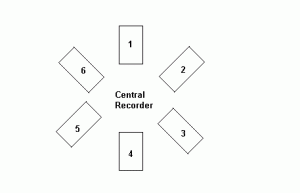Group Observing
Group watches should be made using the standard technique of the BAA Meteor Section (instructions available as a separate leaflet). All observers in the Group should face at equally spaced intervals around the horizon and looking at an altitude of 50 degrees in the centre of their respective areas.

A total of 6 observers is the best number for optimum coverage of the sky. The observations of each group member should be recorded by a central Recorder who is not included as an observer, but is solely committed to getting all the information down onto report forms as quickly as possible, The job of Recorder is quite onerous, especially near the maxima of active showers such as the Perseids, and it is best to rotate this person one step per hour around the circle of observers.
Information noted by each observer in the Group should be the same as that recorded by a single person. The essential difference is that a Group observer should must communicate this information verbally to the central Recorder in a quick, unambiguous fashion. Remember that meteors may often occur in bursts of 2 or 3 only a few seconds apart, and this will mean several observers in the group may have to wait their turn to call out the information. The details of each meteor seen should be preceded in the report by the name of the observer(s) who saw it. If several observers see the same meteor but differ in their opinions of certain details, then record all the different facts, with the relevant observer initials noted by each.
One major advantage of the Group system is that all observers, except the Recorder, can be completely muffled up from the cold, in sleeping bags on airbeds, sun-loungers or deckchairs, with only their faces protruding from cover. This is especially beneficial in the winter, when intense cold can otherwise curtail meteor watches severely! Further, as none of the observers in the Group ever need to take their eyes off the sky, this results in a greater total number of meteors seen and, therefore, more efficient monitoring of shower activity. Another benefit of the Group is that the company of other observers helps to keep up morale when the weather is poor, rates are low, or if there is a protracted lull in meteor activity.
In a major shower, with 6 observers, near peak rates many meteors can appear within a short interval, and it is essential to remain calm and not panic, so that the information can all be recorded in chronological order of sighting by the Recorder.
If you are fortunate enough to have more than 8 observers, available for use in your meteor recording group, then, rather than having a huge unwieldy group with, say, 12 people, make use of them in one of to ways:
a) Arrange an observing rota, with different observers out your total number ‘on call’ each night – say 6 at a time. This enables coverage of many consecutive nights, with some observers resting, while others take part in the Group. Also, most observers will have some nights when they have other commitments, and a large pool of observers means that they can take part as they wish without leaving the Group short. NB: Coverage of many consecutive nights is essential during a shower like the Perseids, because it is just as important to monitor activity for a week either side of maximum, as it is to observe the peak.
b) If you have a very large number of observers available on one night, then set up two completely independent Groups about 20 km or so apart. This is especially useful during patchy weather or fast-moving cloud: cloudy sky at one location may be compensated by clear conditions at the other.
If on any occasion you have 3 or less observers available, then do away with the central Recorder, and note meteors individually on separate lines of the Report Form as detailed in the “Visual Observing Notes” leaflet. In any case, with only a few observers keep facing at equally spaced intervals around the horizon, looking towards the 50 degrees altitude level.
One final word of warning, of your Group travels to a remote part of the countryside to get a really dark sky. Make sure you have some form of serviceable transport available throughout the night, or are near a working telephone. Also, remember to take a First Aid kit, and try to have at least one Group member trained in First Aid. You would be surprised how often this can come in handy.
Group work represents one of the most useful formats of amateur meteor study in that it yields visual results which usually form a very co-ordinated and consistent sample, and are the easiest to analyse accurately to obtain true sporadic and shower rates.
| The British Astronomical Association supports amateur astronomers around the UK and the rest of the world. Find out more about the BAA or join us. |
